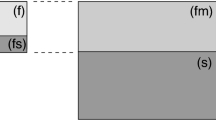Abstract
This study focuses on the numerical modelling of the concentrated leak erosion of a cohesive soil by turbulent flow in axisymmetrical geometry, using the Hole Erosion Test (HET). The numerical model is based on the adaptive remeshing of the water/soil interface to ensure the accurate description of the mechanical phenomena occurring near the soil/water interface. The erosion law governing the interface motion is based on two erosion parameters: critical shear stress and the erosion coefficient. The model is first validated in the case of 2D piping erosion caused by laminar flow. Then, the numerical results are compared with the interpretation model of the HET. Three HETs performed on different soils are modelled with rather good accuracy. Lastly, a parametric analysis of the influence of the erosion parameters on erosion kinetics and the evolution of the channel diameter is performed. Finally, after this validation by comparison with both the experimental results and the interpretation of Bonelli et al. [2], our model is now able to accurately reproduce the erosion of a cohesive soil by a concentrated leak. It also provides a detailed description of all the averaged hydrodynamic flow quantities. This detailed description is essential in order to achieve better understanding of erosion processes.











Similar content being viewed by others
References
Benahmed N, Bonelli S (2012) Investigating concentrated leak erosion behaviour of cohesive soils by performing hole erosion tests. Eur J Environ Civ Eng 16(1):43–58
Bonelli S, Brivois O, Borghi R, Benahmed N (2006) On the modelling of piping erosion. Comptes Rendus de Mécanique 334(8–9):555–559
Bonelli S, Brivois O (2008) The scaling law in the hole erosion test with a constant pressure drop. Int J Numer Anal Meth Geomech 32:1573–1595
Bonelli S, Golay F, Mercier F (2012) Chapter 6 - On the modelling of interface erosion. In: Erosion of geomaterials, Wiley/ISTE
Brivois O, Bonelli S, Borghi R (2007) Soil erosion in the boundary layer flow along a slope: a theoretical study. Eur J Mech B Fluids 26:707–719
Chen HC, Patel VC (1988) Near-wall turbulence models for complex flows including separation. AIAA J 26(6):641–648
Donea J, Guiliani S, Halleux JP (1982) An arbitrary lagrangian Eulerian finite element method for transient dynamics fluid structure interaction. Comp Meth Appl Mech Eng 33:689–723
Golay F, Lachouette D, Bonelli S, Seppecher P (2010) Interfacial erosion: a three-dimensional numerical model. Comptes Rendus de Mécanique 338:333–337
Lachouette D, Golay F, Bonelli S (2008) One dimensional modelling of piping flow erosion. Comptes Rendus de Mécanique 336:731–736
Launder BE, Spalding DB (1972) Lectures in mathematical models of turbulence. Academic Press, London
Osher S, Sethian J (1981) Fronts propagating with curvature dependent speed: algorithm foot tracking material interface. J Comput Phys 39:201–225
Ouriemi M, Aussillous P, Médale M, Peysson Y, Guazzelli E (2007) Determination of the critical Shields number for particle erosion in laminar flow. Physics of Fluids 19:061706. doi:10.1063/1.2747677
Pope SB (2000) Turbulent Flows. Cambridge University Press, Cambridge
Regazzoni P-L, Marot D (2011) Investigation of interface erosion rate by Jet Erosion Test and statistical analysis. Eur J Environ Civ Eng 15(8):1167–1185
Shih T-H, Liou WW, Shabbir A, Yang Z, Zhu J (1995) A new k-epsilon eddy-viscosity model for high Reynolds number turbulent flows: model development and validation. Comput Fluids 24(3):227–238
Vardoulakis I, Stavropoulou M, Papanastasiou P (1996) Hydromechanical aspects of sand production problem. Transp Porous Media 22:225–244
Wan CF, Fell R (2004) Laboratory tests on the rate of piping erosion of soils in embankment dams. J Geotech Test J 27(3):295–303
Wolfshtein M (1969) The velocity and temperature distribution of one-dimensional flow with turbulence augmentation and pressure gradient. Int J Heat Mass Transf 12:301–318
Acknowledgments
The authors are grateful to the Centre d’Ingénierie Hydraulique of EDF and geophyConsult for their financial support. They also extend special thanks to Mrs Patrick Pinettes (geophyConsult), Jean-Robert Courivaud (EDF) and Jean-Jacques Fry (EDF) for their support and confidence. This work was also funded by the French National Research Agency (ANR) through the COSINUS programme (project CARPEINTER No.ANR-08-COSI-002).
Author information
Authors and Affiliations
Corresponding author
Rights and permissions
About this article
Cite this article
Mercier, F., Bonelli, S., Golay, F. et al. Numerical modelling of concentrated leak erosion during Hole Erosion Tests. Acta Geotech. 10, 319–332 (2015). https://doi.org/10.1007/s11440-014-0349-5
Received:
Accepted:
Published:
Issue Date:
DOI: https://doi.org/10.1007/s11440-014-0349-5




